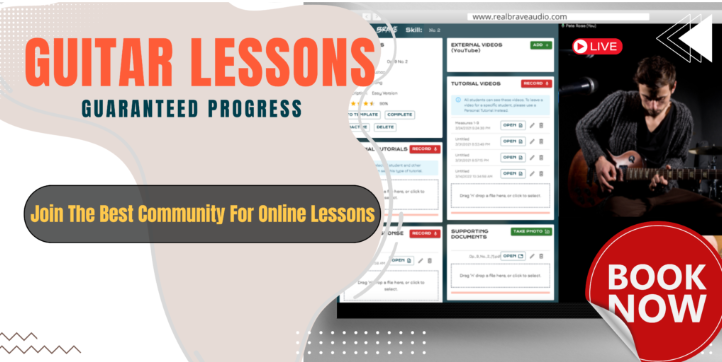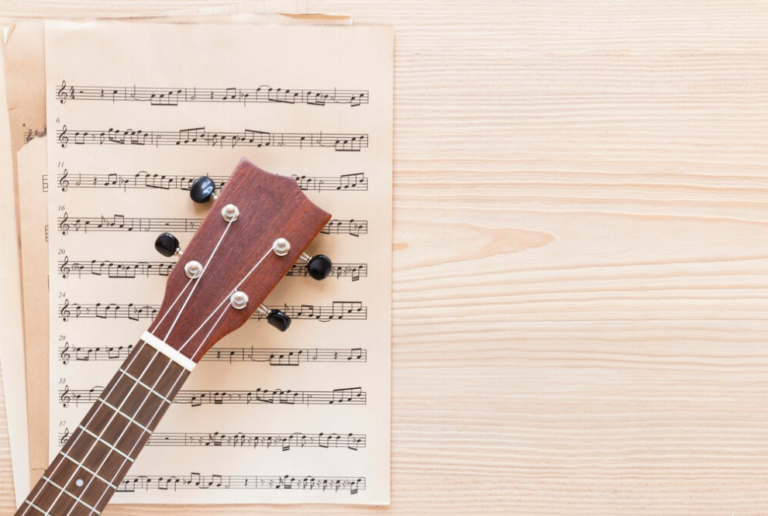The Amazing Sound of The Major Scale on Guitar
Here’s a detailed guide on how to play the major scale in the open position, using the C major and G major scales as an example.
You clicked it, you got it. A How To Play The Major Scale guide.
At Real Brave, we guarantee progress in learning, and here is a comprehensive guide that focuses exclusively on guitar. We will focus on the open position C major scale and the closed position G. If you want more, please email me dan@realbraveaudio.com otherwise this will be way too long! Who has the attention span for that?
How to Play the Major Scale on Guitar: Starting with Open Position Scales
Step 1: Playing the C Major Scale in Open Position
- First Note (C): Place your ring finger on the 3rd fret of the A string and play this note (C).
- Second Note (D): Next, play the open D string (no fingers on the fretboard), which is the second note of the scale.
- Third Note (E): Place your index finger on the 2nd fret of the D string to play E.
- Fourth Note (F): Use your ring finger to press the 3rd fret of the D string, giving you F.
- Fifth Note (G): Play the open G string for the fifth note.
- Sixth Note (A): Press the 2nd fret of the G string with your index finger for the A note.
- Seventh Note (B): Use your ring finger on the 4th fret of the G string to play B.
- Octave (C): Finally, play the open B string for the higher octave C note.
Step 2: Understanding the Scale Pattern
Scale Pattern: The major scale follows a specific pattern of whole steps and half steps. For the guitar, a whole step means skipping one fret, while a half step means moving to the next fret. The pattern for the major scale is: Whole, Whole, Half, Whole, Whole, Whole, Half.
Step 3: Positioning for the C Major Scale
Starting Note: Locate the starting note of the C major scale. For this scale in the open position, the starting note is C. On the guitar, this is the 3rd fret on the A string.
Step 4: Descending the Scale
Repeat the process in reverse order to descend back down the scale. Ensure that each note is played clearly and in time.
Step 5: Practice and Repetition
- Slow Practice: Initially, play the scale slowly, focusing on the clarity of each note and the smoothness of transitions between notes.
- Metronome Use: As you get comfortable, use a metronome to practice playing the scale in time. Gradually increase the speed as you become more confident.
- Alternate Picking: Practice alternate picking (down-up picking) to improve your picking hand efficiency.
Step 6: Expanding to Other Scales
Once you are comfortable with the C major scale, apply the same pattern to learn other major scales in open positions, such as G major and D major.
Playing the G Major Scale in a Closed Position
Step 1: Locate the Starting Note
Starting Note for G Major: Find the G note on the low E (6th) string located at the 3rd fret.
Step 2: Finger Placement and Scale Pattern
- First Note (G): Start by placing your middle finger on the 3rd fret of the low E string to play G.
- Second Note (A): Play the A note by placing your pinky finger on the 5th fret of the same string.
- Third Note (B): Shift to the A (5th) string, playing B with your index finger on the 2nd fret.
- Fourth Note (C): Still on the A string, use your middle finger to play C at the 3rd fret.
- Fifth Note (D): Use your pinky to play D at the 5th fret of the A string.
- Sixth Note (E): Move to the D (4th) string and play E with your index finger on the 2nd fret.
- Seventh Note (F#): Play F# at the 4th fret with your ring finger on the D string.
- Octave (G): Complete the octave by playing G on the D string at the 5th fret with your pinky.
Step 3: Ascending and Descending the Scale
- Ascending: Practice playing the scale upwards, starting from the low G to the higher G.
- Descending: Reverse the process and play the scale downwards, from the higher G back to the lower G.
Step 4: Practice and Repetition
- Slow Practice: Initially, play the scale slowly, focusing on clean fingering and smooth transitions between notes.
- Consistency: Practice the scale regularly, gradually increasing speed and ensuring each note is clear and on time.
- Alternate Picking: Employ alternate picking (down-up picking) throughout to develop your picking hand technique.
Learning Closed Position Scales on Guitar: A Detailed Guide
After mastering open-position scales, progressing to closed-position scales is a crucial step in enhancing your guitar skills. Closed position scales, such as the G major scale starting on the 3rd fret of the low E string, are invaluable because they are movable shapes. This means you can play the same scale shape in any key by shifting the starting point along the fretboard. Let’s dive deep into learning how to play closed-position scales on the guitar.
Understanding Closed Position Scales
- Closed Position: Unlike open position scales that utilize open strings, closed position scales use fretted notes exclusively. This makes them movable up and down the neck, allowing you to play in any key using the same fingering pattern.
- Movable Shapes: Learning these scale patterns enables you to play the major scale in any key, simply by shifting the starting note to the corresponding root note of the desired scale.
Expanding to Other Keys
- Shifting the Scale Shape: Once you’re comfortable with the G major scale, practice moving the entire shape to different starting notes. For example, moving the starting note to the 5th fret (A note) on the low E string will give you the A major scale in closed position.
- Exploring the Fretboard: Practice scales in various keys to familiarize yourself with the entire fretboard. This exercise enhances your understanding of scale patterns and key relationships.
Exploring All Keys
- Practice scales in all keys, gradually introducing scales with sharps and flats. This practice enhances your understanding of the fretboard and improves your versatility as a guitarist.
Scale Sequences and Techniques
- Develop dexterity and musicality by practicing scales in various sequences, such as in thirds or fourths. Incorporate techniques like alternate picking and fingerpicking for skill enhancement.
Real Brave’s Solution for Guitar Major Scales
Real Brave’s approach to teaching major scales on the guitar for guaranteed progress, featuring:
- Next-Gen Virtual Classroom Experience: 1-1 lessons online with an instructor in our private lesson rooms. This unique system tracks your practice sessions and progress, providing a clear view of your improvement and areas that need focus.
- Dynamic Learning Hub, Instant Progress Insight: Our lessons are tailored to each student’s learning style and pace, ensuring a personal and effective learning experience.
- Expert Instructors: Our experienced guitar instructors guide you through each scale with clear, step-by-step instructions, making even complex scales accessible and understandable. Live 1-1.
- Setting Clear Goals: We set achievable goals for each lesson, ensuring you make consistent progress in mastering the major scale on the guitar.
Mastering the major scale on the guitar is a journey of persistence, practice, and proper guidance. At Real Brave, we are committed to ensuring you not only learn the major scale but also apply it effectively in your guitar playing. With our expert instruction and supportive learning environment, your mastery of the major scale on guitar is guaranteed. Let Real Brave be your guide on this exciting musical adventure.






